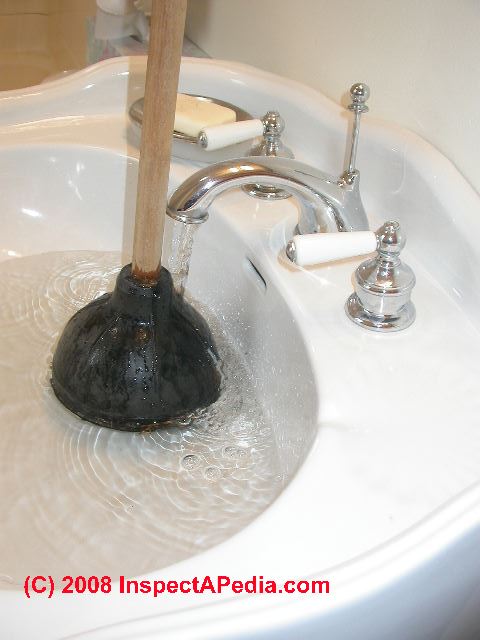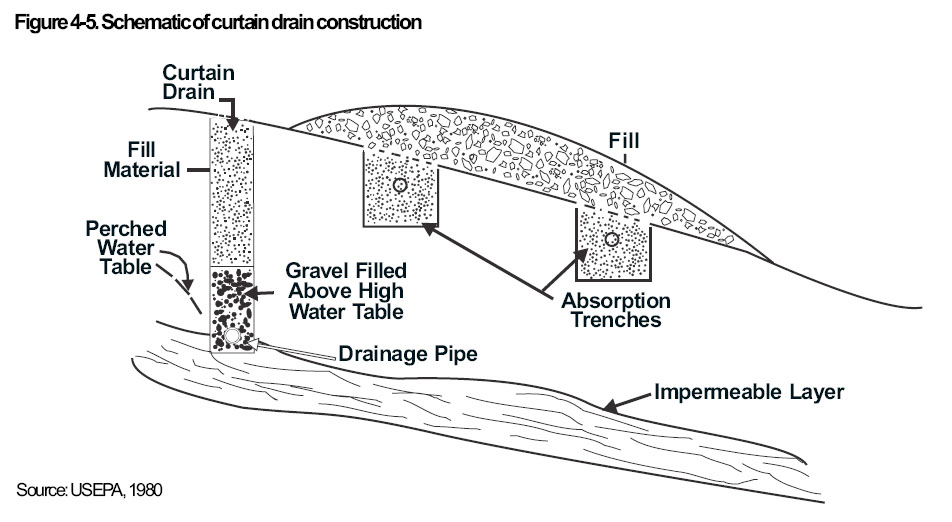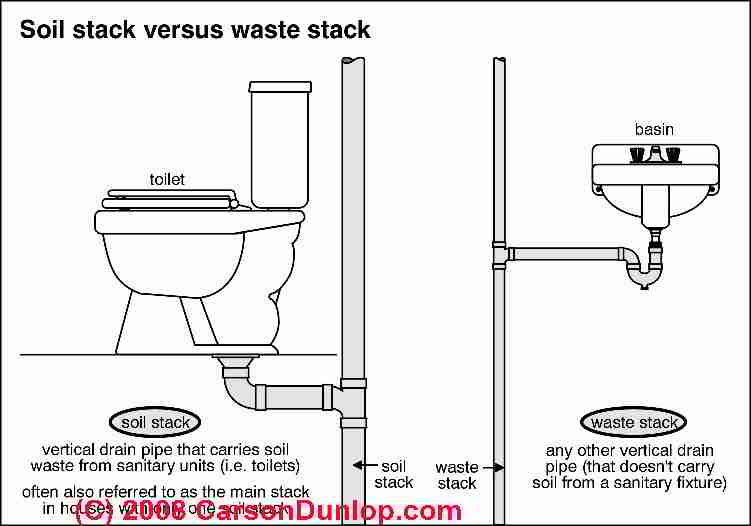 Diagnose Clogged Drain vs Septic Backup or Failure
Diagnose Clogged Drain vs Septic Backup or Failure
Blocked Drain Diagnosis for Building Owners/Managers
- POST a QUESTION or COMMENT about how to diagnose & repair slow or clogged building drains
Blocked drain or drain backup diagnosis: caused by drain blockage versus caused by septic system failure: here we explain how to determine if a blocked or slow drain is due to a problem inside the building or outside in a sewer line or failing septic system.
When a building drain or main sewer line is clogged or slow, or when there is a septic system backup, it's important to determine where the problem lies, since the repair steps can be quite different and costs can vary widely.
InspectAPedia tolerates no conflicts of interest. We have no relationship with advertisers, products, or services discussed at this website.
- Daniel Friedman, Publisher/Editor/Author - See WHO ARE WE?
Is the slow drain problem due to indoor plumbing or the septic system?
Is it a Plumbing Problem or a Septic System Problem - A First Look
Sewage odors, wet areas on the property, slow fixture drains, gurgling drain noises, or plumbing fixtures which "back up" or overflow back into the building may be the first signs of trouble at a property. Image courtesy of Carson Dunlop Associates, a Toronto home inspection, education & report writing tool company [ carsondunlop.com ].
[Click to enlarge any image]
If there are sewage odors or soggy sewage-smelling wet areas at a property, the on-site waste disposal system is likely to be at fault. Even so, without further investigation we don't know yet if the problem is a simple repair such as a broken pipe underground, or a costly failure such as a saturated absorption field.
If building drains are slow or clogged, the problem could be the in-building plumbing drain-waste-vent (DWV) system or there may be a problem with the septic system. Without further investigation we don't know.
Also see these clues (and articles about them) that assist in diagnosing clogged drains, drain backups, and septic or sewage odors:
- PLUMBING DRAIN NOISE DIAGNOSIS: may indicate defective or clogged plumbing: how to diagnose and cure drain sounds
- SEWER GAS ODORS - a step by step guide to tracking down where smells and sewer gas odors are coming from
- SEWAGE ODORS in COLD WEATHER - Septic Odors or Sewage Odor Diagnosis & Repair Guide for diagnosing and eliminating cold weather sewer gas odors
- For sewer or septic backups,
see SEPTIC BACKUP PREVENTION
and SEPTIC BACKUP REPAIR - TOILET REPAIR GUIDE - how to fix a clogged or poor-flushing toilet - the problem could be the toilet or its controls, not the drain itself
A simple initial step must be taken to distinguish between an in-building plumbing problem and an (outside) on-site waste disposal system problem.
Simply put, if a single building fixture is sluggish or clogged, but if other building fixtures drain properly, you should suspect a local clog or vent problem at the individual fixture.
If all building drains are slow or clogged, or if waste is backing up into the building from the lowest plumbing fixture, you would suspect the sewe line is blocked or there is a failing or blocked onsite waste disposal system (septic system).
Our client (left) is pointing to a leaky clamp patch on a building drain line. Odd and excessive slope, a mix of materials, and this patch were evidence of amateur workmanship that presaged problems with this drain system.
Curtain Drain - Design Sketch for Protecting Drainfields from Wet Soils

Inspect the septic system absorption field: if the drain field (synonyms: leach field, leaching bed, soakbed, absorption bed, seepage bed, seepage trench) is wet or smelly we suspect a septic absorption field failure.
If the absorption fields
are properly installed there is adequate clearance, typically 4.5 ft. between the bottom of the field and the top of the seasonal (spring)
high water table on the property.
Otherwise in wet weather conditions your field is flooded, cannot readily accept effluent from the tank,
and worse, you're also contaminating the local groundwater with pathogens from the septic tank.
If your absorption field is on a slope and is
subject to high levels of surface or subsurface runoff, you may need to install an intercept drain or curtain drain (sketch above, source US EPA) up-slope from the
absorption field.
Details are at FLOODED SEPTIC SYSTEMS, REPAIR.
Keep the intercept drain or curtain drain at least 10 meters from the absorption field perimeter.
If the septic field is flooded and you do not have problems with surface runoff, subsurface runoff, or high water table, before you assume that the field is at the end of its life, check for constantly running plumbing fixtures such as running toilets or a water softener which is stuck in its "backwash" cycle.
If exploration of the on-site waste disposal system piping from house to tank, tank to distribution box, and distribution box to drainfield indicates that the failure is in the drainfield (or absorption system), a more extensive system repair is needed and significant costs are likely to be incurred.
for a discussion of camping toilets, chemical toilets, emergency-use toilets, waterless toilets, graywater systems, composting toilets, home health care toilets, incinerating toilets, outhouses, and latrines.
and SEWER LINE REPLACEMENT diagnosing a clogged drain leads to drain line replacement - step by step photo-illustrated guide to drain replacement.
...
Continue reading at CLOGGED DRAIN DIAGNOSTIC CHART or select a topic from the closely-related articles below, or see the complete ARTICLE INDEX.
Or see CLOGGED DRAIN vs SEPTIC BLOCKAGE FAQs questions & answers posted originaly at this article
Or see these
Plumbing Drain Articles
- CLOGGED DRAIN DIAGNOSIS & REPAIR - home
- CLOGGED SUPPLY PIPES, DIAGNOSIS
- DRAIN & SEWER PIPING - home
- SEPTIC BACKUP PREVENTION
- SEPTIC BACKUP REPAIR - home
Suggested citation for this web page
CLOGGED DRAIN vs SEPTIC PROBLEM at InspectApedia.com - online encyclopedia of building & environmental inspection, testing, diagnosis, repair, & problem prevention advice.
Or see this
INDEX to RELATED ARTICLES: ARTICLE I NDEX to PLUMBING SYSTEMS
Or use the SEARCH BOX found below to Ask a Question or Search InspectApedia
Ask a Question or Search InspectApedia
Try the search box just below, or if you prefer, post a question or comment in the Comments box below and we will respond promptly.
Search the InspectApedia website
Note: appearance of your Comment below may be delayed: if your comment contains an image, photograph, web link, or text that looks to the software as if it might be a web link, your posting will appear after it has been approved by a moderator. Apologies for the delay.
Only one image can be added per comment but you can post as many comments, and therefore images, as you like.
You will not receive a notification when a response to your question has been posted.
Please bookmark this page to make it easy for you to check back for our response.
IF above you see "Comment Form is loading comments..." then COMMENT BOX - countable.ca / bawkbox.com IS NOT WORKING.
In any case you are welcome to send an email directly to us at InspectApedia.com at editor@inspectApedia.com
We'll reply to you directly. Please help us help you by noting, in your email, the URL of the InspectApedia page where you wanted to comment.
Citations & References
In addition to any citations in the article above, a full list is available on request.
- Septic Tank/Soil-Absorption Systems: How to Operate & Maintain [ copy on file as /septic/Septic_Operation_USDA.pdf ] - , Equipment Tips, U.S. Department of Agriculture, 8271 1302, 7100 Engineering, 2300 Recreation, September 1982, web search 08/28/2010, original source: http://www.fs.fed.us/t-d/pubs/pdfimage/82711302.pdf.
- Operation & Maintenance Manual for Septic Tank Drainfield Sewer Systems, Missoula MT: NOrthern Region, Environmental Health Engineering, Forest Service, U.S. Department of Agriculture, August 1981. Cited by the above reference.
- Pennsylvania State Fact Sheets relating to domestic wastewater treatment systems include
- Pennsylvania State Wastewater Treatment Fact Sheet SW-161, Septic System Failure: Diagnosis and Treatment
- Pennsylvania State Wastewater Treatment Fact Sheet SW-162, The Soil Media and the Percolation Test
- Pennsylvania State Wastewater Treatment Fact Sheet SW-l64, Mound Systems for Wastewater Treatment
- Pennsylvania State Wastewater Treatment Fact Sheet SW-165, Septic Tank-Soil Absorption Systems
- Document Sources used for this web page include but are not limited to: Agricultural Fact Sheet #SW-161 "Septic Tank Pumping," by Paul D. Robillard and Kelli S. Martin. Penn State College of Agriculture - Cooperative Extension, edited and annotated by Dan Friedman (Thanks: to Bob Mackey for proofreading the original source material.)
- Our recommended books about building & mechanical systems design, inspection, problem diagnosis, and repair, and about indoor environment and IAQ testing, diagnosis, and cleanup are at the InspectAPedia Bookstore. Also see our Book Reviews - InspectAPedia.
- In addition to citations & references found in this article, see the research citations given at the end of the related articles found at our suggested
CONTINUE READING or RECOMMENDED ARTICLES.
- Carson, Dunlop & Associates Ltd., 120 Carlton Street Suite 407, Toronto ON M5A 4K2. Tel: (416) 964-9415 1-800-268-7070 Email: info@carsondunlop.com. Alan Carson is a past president of ASHI, the American Society of Home Inspectors.
Thanks to Alan Carson and Bob Dunlop, for permission for InspectAPedia to use text excerpts from The HOME REFERENCE BOOK - the Encyclopedia of Homes and to use illustrations from The ILLUSTRATED HOME .
Carson Dunlop Associates provides extensive home inspection education and report writing material. In gratitude we provide links to tsome Carson Dunlop Associates products and services.



